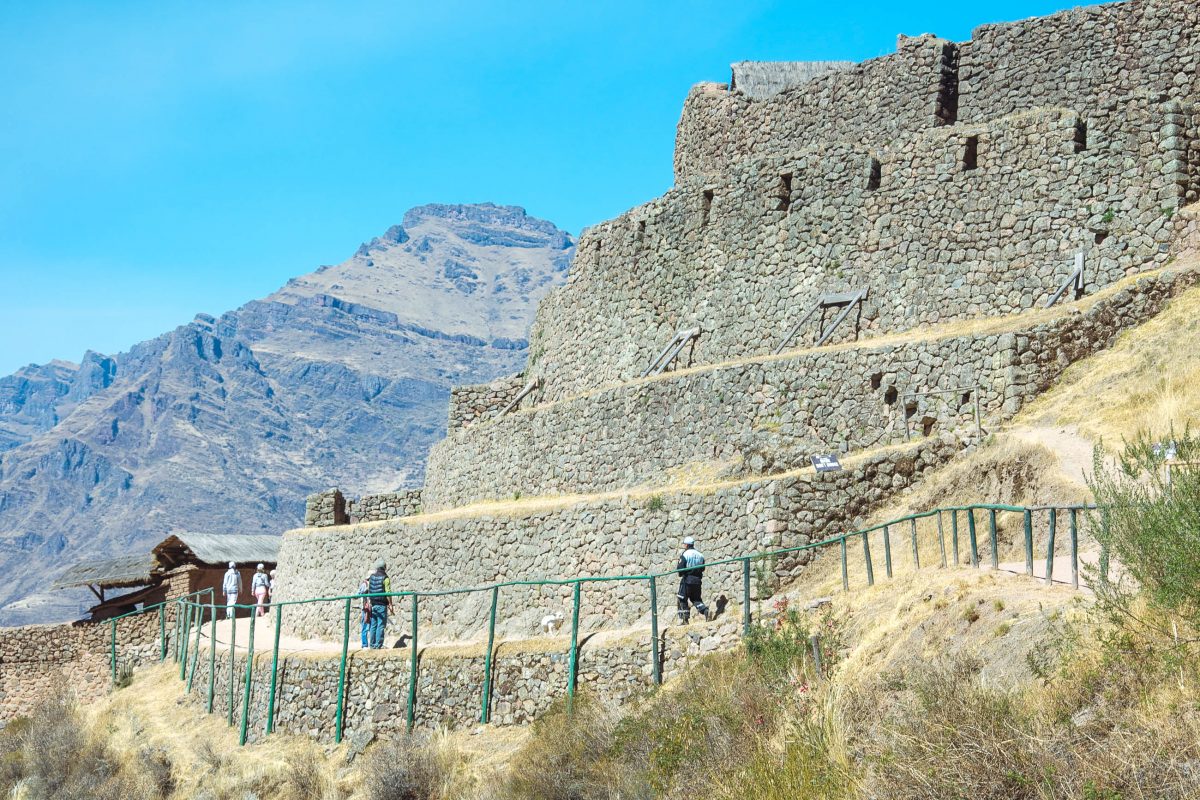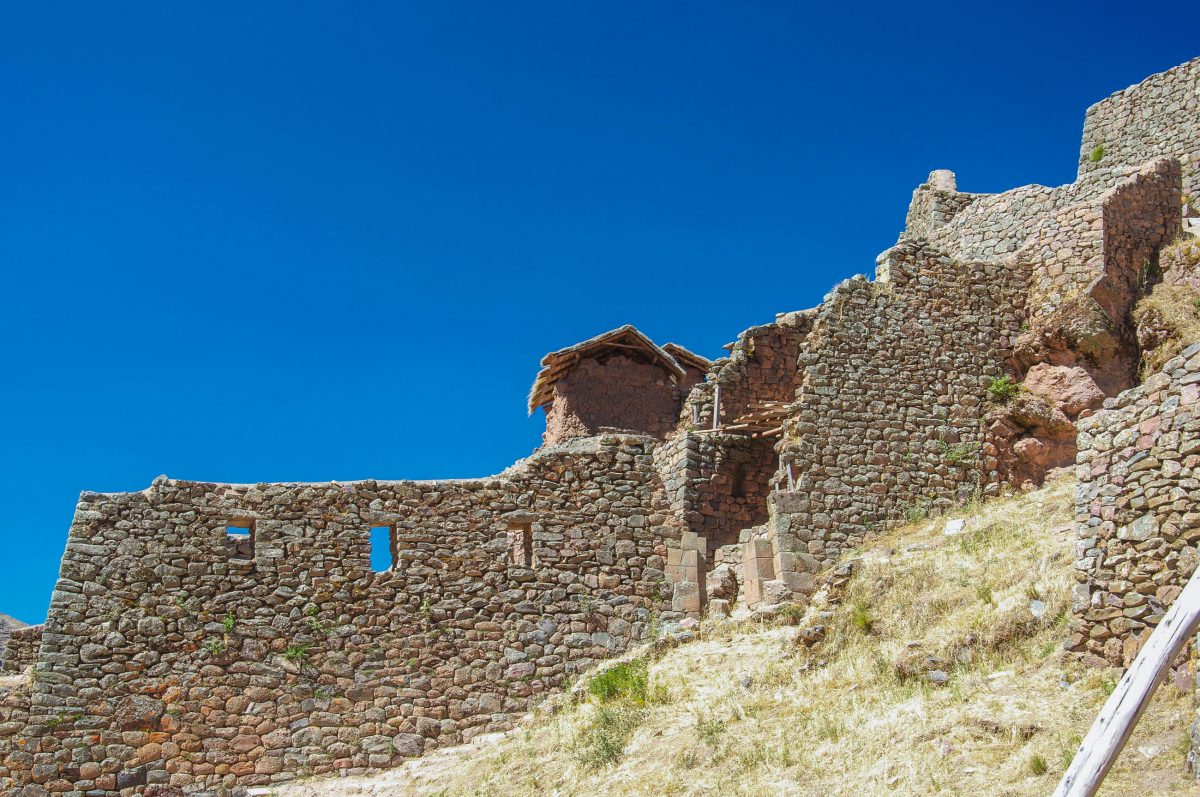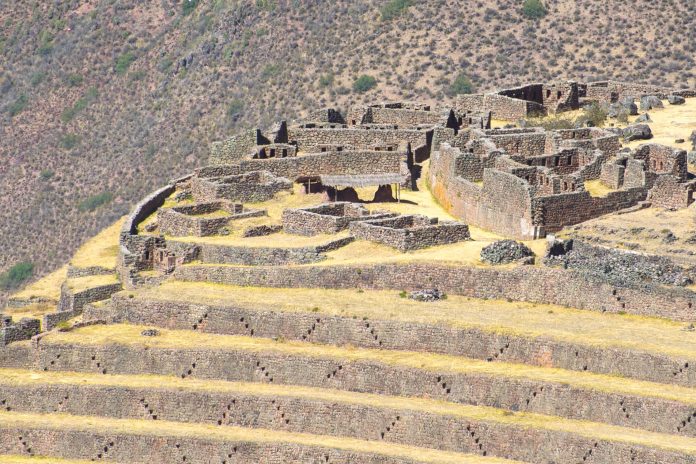Die einstige Inka-Stadt Pisac im berühmten Valle Sagrado, dem Heiligen Tal der Inka, ist heute mit seinem weit bekannten Markt und den altehrwürdigen Inka-Ruinen eine beliebte Sehenswürdigkeit in Peru.
Pisac, in Quechua auch „Pisaq“ geschrieben, liegt im südlichen Peru auf 3.000 Metern Seehöhe etwa 33km nordöstlich der Königsstadt Cusco am Fluss Urubamba. Das genaue Gründungsdatum von Pisac ist nicht bekannt, Experten schätzen seine Entstehung jedoch um das Jahr 1440.
Wie Ollantaytambo im Norden bewachte Pisac vermutlich den südlichen Eingang zum Valle Sagrado im Süden von Peru. Die historische Stätte hatte für die Inka somit dreierlei Bedeutung: als Festung, Zeremonienstätte und für die Landwirtschaft, die auf den unzähligen Terrassen heute noch betrieben wird.
In den 1530er-Jahren wurde Pisac von den spanischen Eroberern zerstört, das heutige Erscheinungsbild des Ortes stammt aus den 1570er-Jahren und wurde auf Anweisung des spanischen Vizekönigs Toledo wieder aufgebaut.
Inhaltsverzeichnis
BILDER: Inka-Stadt Pisac
Markt von Pisac
Der weithin bekannte und bei Touristen äußerst beliebte Markt von Pisac findet am zentralen Plaza de Armas statt. Hier bauen die Marktfrauen jeden Dienstag, Donnerstag und Sonntag ihre Stände auf. Auch die angrenzenden Gassen werden dann zum – meist ziemlich überlaufenen – Freiluft-Shop.
Angeboten werden verschiedenste Arten von Süßkartoffeln, Obst, Zwiebeln, Mais, Quinoa, Schmuck, Malereien, handgemachte Produkte aus Leder und Wolle, bunte Wandteppiche, Mützen und Pullover und natürlich auch jede Menge touristischer Ramsch.
Auch wer nichts kaufen möchte, sollte sich diesen Markt nicht entgehen lassen, denn die Mädchen, Frauen und Kinder in Pisac sind alle in ihrer typisch peruanischen farbenfrohen Tracht gekleidet – ob aus nostalgischen oder verkaufsfördernden Gründen sei dahingestellt.
Tipp: Auch im nahegelegenen Chinchero findet ein peruanischer Markt mit traditioneller Tracht statt. Dieser ist nicht ganz so touristisch, sondern dient in erster Linie noch der Versorgung der einheimischen Bevölkerung.
Sonntagsmarkt und traditionelle Zeremonie
Sowohl die Anzahl der Händler als auch der Touristen erreicht am Sonntag ihren Höhepunkt. Jeden Sonntag gibt es am Hauptplatz von Pisac noch ein zusätzliches Schauspiel zu beobachten.
Nach dem Hochamt schreiten die Bürgermeister von Pisac und den Nachbardörfern mit ihren Assistenten von der Dorfkirche zum Pfarrhaus – mit Amtstracht und Amtsinsignien voll ausgestattet – um dort zu beraten und gemeinsam Mittag zu essen. Die Luft ist erfüllt vom Duft nach „chicha“ (Maisbier) und frischem Fladenbrot, das noch traditionell in alten Lehmöfen gebacken wird.
Tipp: Der Markt von Pisac ist eindeutig ausschließlich auf den Tourismus ausgelegt. Die Preise für die Waren und auch für die Menüs in den Restaurants sind oft exorbitant und werden manchmal scheinbar beliebig erhöht. Auch Taschendiebe treiben ihr Unwesen!
Inka-Ruinen von Pisac

Ob des beliebten Marktes von Pisac werden die uralten Inka-Ruinen oft kaum beachtet – zu Unrecht, denn sie sind nahezu ebenso faszinierend wie jene von Machu Picchu. Über eine 10km lange, kurvenreiche Straße sind zwei mögliche Ausgangspunkte für eine Erkundung von Pisacs Ruinen zu erreichen.
Als Alternative führt ein steiler, 4km langer Weg nach oben. Auf schmalen Pfaden können die Überreste von Mauern und einfachen Gebäudestrukturen besichtigt werden. An der Flanke des Berges führt ein schmaler Weg von den Ruinen zum unteren Parkplatz oder ein steiler, direkter Pfad bis zum Plaza de Armas von Pisac. Der Abstieg nach Pisac dauert mit gutem Schuhwerk und sicherem Tritt etwa eine halbe Stunde.
Terrassen von Pisac

Das erstaunlichste an den Ruinen von Pisac sind die unzähligen Terrassen, die die steilen Hänge der Anden durch ein ausgeklügeltes Bewässerungssystem fruchtbar machen. Die Terrassen enthalten außerdem ein fantastisches Geheimnis: Vom richtigen Winkel gesehen bilden sie die Form eines Kondors mit ausgebreiteten Flügeln. Jener gigantische Vogel galt bei den Inka als Bote der Sonne und geleitete die Toten in die Unterwelt. Andere Quellen sprechen von einem Rebhuhn, „pisaca“ in Quechua, das dem Ort seinen Namen gab.
Die meterhohen Terrassen von Pisac werden heute noch bewirtschaftet und sind durch lange Treppen miteinander verbunden. In regelmäßigen Abständen ragen Zapfen aus den Terrassenwänden, die einerseits die Mauer stabilisieren und andererseits den Aufstieg abseits der Treppenfluchten ermöglichen. Von den Terrassen und den Plateaus tun sich immer wieder spektakuläre Ausblicke über Pisac und das Heilige Tal der Inka auf.
Zeremonien-Zentrum, Sonnentempel und Inka-Friedhof

Seit Jahrhunderten thront ca. 600 Meter über dem Plaza de Armas ein Zeremonien-Zentrum, dessen Mauern und Hütten heute noch gut zu sehen sind.
Am höchsten Plateau in der Mitte des Tempelbereichs liegt der Tempel des Sonnengottes Inti mit dem „Intihuatana“. An diesen Felsblock war nach dem Glauben der Inka die Sonne angebunden, er diente wohl zur Unterscheidung der Jahreszeiten.
Im Hintergrund der Inka-Ruinen von Pisac sind unzählige Löcher in den Felswänden sichtbar. Dies sind die Eingänge zu über 2.000 Gräbern, die einen der größten Inka-Friedhöfe Perus bilden und zum Teil noch Mumien enthielten.
Tipp: Der Besuch der Inka-Ruinen von Pisac ist im Boleto Turistico (Cusco Touristen-Ticket) inbegriffen!
Weiterführende Links:





